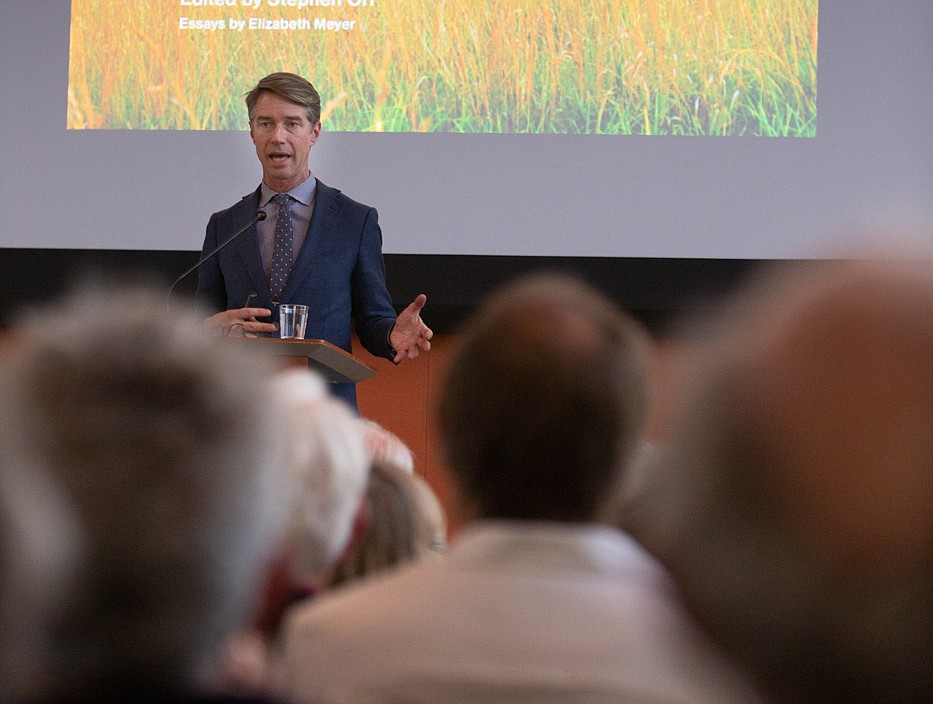Cultivating Hope in Damaged Landscapes
Landscape Architect Thomas Woltz Visits Westmont College

Thomas Woltz, one of America’s leading landscape architects, spoke at the Westmont College Global Leadership Center on March 12, offering hope and inspiration for community members still reeling from the devastating Thomas Fire and 1/9 Debris Flow. The Garden Club of Santa Barbara offered the free public event so that Woltz, with his thoughtful and creative approaches to resurrecting damaged land, might provide encouragement as the community finds its way forward.
“Healing the land can be symbolic of healing a community,” Woltz emphasized. “A moment of grace occurs when you enter the landscape and discover the stories it has to tell. Ask what is the history, what are the dynamics, who are your people. The stories of who we are and how we got here are under our feet; listen to these stories, they can lead to the future. The more awe and respect we have for these stories, the more resilient our landscapes will become and the greater partnership we will forge.”
Woltz spoke of several damaged landscapes that he and his firm — Nelson Byrd Woltz Landscape Architects, based in Virginia — have restored to vitality and balance.
Orongo Station, North Island, New Zealand
Woltz and his team reestablished the area’s original rain forest ecology, planting more than 600,000 trees, and attracted wildlife back to the area, including the tuatara, a prehistoric reptile as old as the first dinosaurs. All of this was woven into a profitable working sheep and cattle farm and agricultural operation. Much of this land is sacred to the local Maori people, and that informed and inspired much of the landscape design. “By looking back, we found a way forward to establish a balance of culture and ecology,” Woltz said.
Flight 93 National Memorial, Shanksville, PA
A former stripmining operation, this park is now a landscape of memory, honoring the individual and collective voices of those killed aboard Flight 93 on 9/11. A circular allée of maples that turn flaming red in early September embraces the field. Woltz portrayed the memorial as “a natural system that eloquently captures the loss of a nation.”
Karen Cragnolin Park, Asheville, NC
This is perhaps the most damaged landscape Woltz has tackled. An automotive dump along the French Broad River contained years of toxic waste and had been paved over with concrete slurry. Old cars lined the river bank. When complete, the riparian park will provide a needed place of repose and welcome in the center of Asheville. Woltz cited this park as a prime example of how “our landscapes must be resilient; they can’t simply be precious.”

Memorial Park, Houston TX
This site, twice the size of New York’s Central Park, had experienced multi-year droughts and a 500-year hurricane and flood. It had suffered an 85 percent loss of tree canopy and was surrounded by freeways. Now well on its way to becoming a healthy and vital city park, Woltz said, “It was designed not in the hope of preventing the virulence of nature, but to establish a resilient ecology that could remain dynamic and balanced in the wake of disasters.”
Bok Tower Gardens, Lake Wales, FL
This park had devolved into a tropical landscape, ignoring the old native Florida flora. By showcasing natives, Woltz’s team hoped to encourage residents to introduce such plants into their own yards, abolishing the ubiquitous green lawns requiring so much water and so many chemicals. The response he wanted from visitors was, “I’d like that in my yard!” Woltz designed a children’s garden as part of the project, where they learn how they are “keystones” in nature and integral to its vitality.
What all of these endeavors have in common, Woltz noted, “is landscape that offers a line of beauty for the eye, stories of place to hold the mind, and an atmosphere of quiet contemplation to hold the heart.”
Event Co-Chair Carol Newman is a member of the Garden Club of Santa Barbara. Founded in 1926, the private nonprofit aims to stimulate the knowledge and love of gardening and to restore, improve, and protect the quality of the environment. For more information, visit gardenclubofsantabarbara.org.




You must be logged in to post a comment.